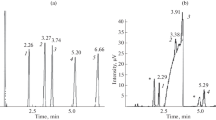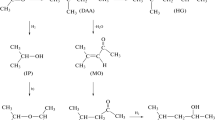Summary
The object of the present study was to determine the usefulness of averaging data obtained from repeated analyses in improving reproducibility of the results, both in terms of retention indices and peak area percentages and to find an optimal compromise between reproducibility and total analysis time. All the necessary calculations are performed by an off-line computer system using a digital integrator and punched tape obtained by a teletype. The standard deviation and the 95% tolerance limits for each peak area percentage in a multiple analysis are readily provided. Stray values are eliminated by means of the t-test.
Similar content being viewed by others
Literature
Kováts, E., Helv. Chim. Acta41, 1915 (1958).Kováts, E., in “Advances in Chromatography”, Vol. I. p. 229 ff., Marcel Dekker Inc., N. Y., 1965.
Ahlberg, J. H., Nilson, E. N., andWalsh, J. L., The Theory of Splines and their Application, Academic Press, New York (1967).
Nalimov, V. V., The Application of Mathematical Statistics to Chemical Analysis. Pergamon Press, Oxford (1963).
Kaiser, R. andGottschalk, G., Elementare Tests zur Beurteilung von Meßdaten. BI Hochschultaschenbücher Bd. 774, Bibliographisches Institut, Mannheim.
Bauer, E. L., A statistical manual for chemists. Academic Press, New York, London (1971).
Grant, D. W. andClarke, A., J. Chromatog.97, 115 (1974).
Grant, D. W. andClarke, A., J. Chromatog.97, 257 (1974).
Grob, K., andGrob, G., Chromatographia5, 3 (1972).
Grob, K., Helv. Chim. Acta51, 718 (1968).
Nečasová, M. andTešarík, K., J. Chromatog.79, 15 (1973).
d'Aubigne, J. M., Landault, C., andGuiochon, G., Chromatographia4, 309 (1971).
Novotný, M. andZlatkis, A., Chromatog. Rev.14, 1 (1971).
Tešarík, K. andNovotný, M. inH. G. Struppe (Editor) Gas Chromatographie, Akademie Verlag, Berlin 1968, p. 575.
Schomburg, G., Husmann, H., andWeeke, F., J. Chromatog.99, 63 (1974).
Kaiser, R., Chromatographie in der Gas-Phase I, BI Hochschultaschenbücher Bd. 22/22a (1966), Bibliographisches Institut Mannheim.
Author information
Authors and Affiliations
Rights and permissions
About this article
Cite this article
Kugler, E., Langlais, R., Halang, W. et al. Temperature programmed analysis of essential oils using glass capillary columns. Chromatographia 8, 468–473 (1975). https://doi.org/10.1007/BF02267585
Issue Date:
DOI: https://doi.org/10.1007/BF02267585




